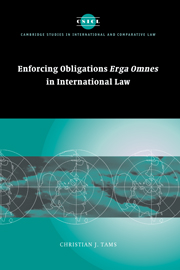Book contents
Foreword
Published online by Cambridge University Press: 24 July 2009
Summary
The subject of obligations erga omnes – obligations to the international community as a whole – their character and possible consequences has been with us ever since the stray dictum of the International Court in the Barcelona Traction case in 1970. The shares in that Canadian company may have become worthless, but huge resources have been put into explaining and accounting for this particular product of the company's failure. And as so much has been said, so opinions have differed. The phrase was used incidentally only to mark out the terrain of diplomatic protection as an inherently bilateral sphere of interstate relations. It was a pretext for an apology for the Court's earlier decision in Second South West Africa – a disaster from a public relations point of view for the Court and a turning point in its relations with the Third World – in short it was law as politics. It showed the Court confronting a new structure of international law, where what matters are not bilateral but multilateral relations and multilateral norms – self-determination, non-discrimination, the prohibition of aggression, fundamental human rights. It showed the Court evading the challenge presented by the concept of peremptory norms of general international law, adopted over the dissent of France at the Vienna Conference in 1969. Where the States (or most of them) would boldly go with a fundamental assertion of core substantive values – or at least of the possibility of such values – the Court would timorously follow, reducing those values to a procedural concept of standing to sue.
- Type
- Chapter
- Information
- Enforcing Obligations Erga Omnes in International Law , pp. xiii - xivPublisher: Cambridge University PressPrint publication year: 2005

